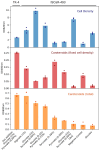A genome-scale metabolic reconstruction provides insight into the metabolism of the thermophilic bacterium Rhodothermus marinus
- PMID: 39716382
- PMCID: PMC11730185
- DOI: 10.1093/femsec/fiae167
A genome-scale metabolic reconstruction provides insight into the metabolism of the thermophilic bacterium Rhodothermus marinus
Abstract
The thermophilic bacterium Rhodothermus marinus has mainly been studied for its thermostable enzymes. More recently, the potential of using the species as a cell factory and in biorefinery platforms has been explored, due to the elevated growth temperature, native production of compounds such as carotenoids and exopolysaccharides, the ability to grow on a wide range of carbon sources including polysaccharides, and available genetic tools. A comprehensive understanding of the metabolism of cell factories is important. Here, we report a genome-scale metabolic model of R. marinus DSM 4252T. Moreover, the genome of the genetically amenable R. marinus ISCaR-493 was sequenced and the analysis of the core genome indicated that the model could be used for both strains. Bioreactor growth data were obtained, used for constraining the model and the predicted and experimental growth rates were compared. The model correctly predicted the growth rates of both strains. During the reconstruction process, different aspects of the R. marinus metabolism were reviewed and subsequently, both cell densities and carotenoid production were investigated for strain ISCaR-493 under different growth conditions. Additionally, the dxs gene, which was not found in the R. marinus genomes, from Thermus thermophilus was cloned on a shuttle vector into strain ISCaR-493 resulting in a higher yield of carotenoids.
Keywords: Rhodothermus marinus; carotenoids; genome-scale metabolic model.
© The Author(s) 2024. Published by Oxford University Press on behalf of FEMS.
Conflict of interest statement
None declared.
Figures



Similar articles
-
Characterization of carotenoids in Rhodothermus marinus.Microbiologyopen. 2018 Feb;7(1):e00536. doi: 10.1002/mbo3.536. Epub 2017 Oct 17. Microbiologyopen. 2018. PMID: 29045010 Free PMC article.
-
Cultivation technology development of Rhodothermus marinus DSM 16675.Extremophiles. 2019 Nov;23(6):735-745. doi: 10.1007/s00792-019-01129-0. Epub 2019 Sep 14. Extremophiles. 2019. PMID: 31522265 Free PMC article.
-
Engineering the carotenoid biosynthetic pathway in Rhodothermus marinus for lycopene production.Metab Eng Commun. 2020 Jul 28;11:e00140. doi: 10.1016/j.mec.2020.e00140. eCollection 2020 Dec. Metab Eng Commun. 2020. PMID: 32793416 Free PMC article.
-
Rhodothermus marinus: physiology and molecular biology.Extremophiles. 2006 Feb;10(1):1-16. doi: 10.1007/s00792-005-0466-z. Epub 2005 Aug 2. Extremophiles. 2006. PMID: 16075163 Review.
-
Genome-Scale Modeling of Thermophilic Microorganisms.Adv Biochem Eng Biotechnol. 2017;160:103-119. doi: 10.1007/10_2016_45. Adv Biochem Eng Biotechnol. 2017. PMID: 27913830 Review.
References
-
- Alfredsson GA, Kristjansson JK, Hjrleifsdottir S et al. Rhodothermus marinus, gen.nov., sp. nov., a thermophilic, halophilic bacterium from submarine hot springs in Iceland. J Gen Microbiol. 1988;134:299–306.
-
- Allahgholi L, Sardari RRR, Hakvåg S et al. Composition analysis and minimal treatments to solubilize polysaccharides from the brown seaweed Laminaria digitata for microbial growth of thermophiles. J Appl Phycol. 2020;32:1933–47. 10.1007/s10811-020-02103-6. - DOI
-
- Andrews S. FastQC, Babraham Bioinformatics. 2010. http://www.bioinformatics.babraham.ac.uk/projects/fastqc/ (1 June 2020, date last accessed).
MeSH terms
Substances
Grants and funding
LinkOut - more resources
Full Text Sources
Molecular Biology Databases

